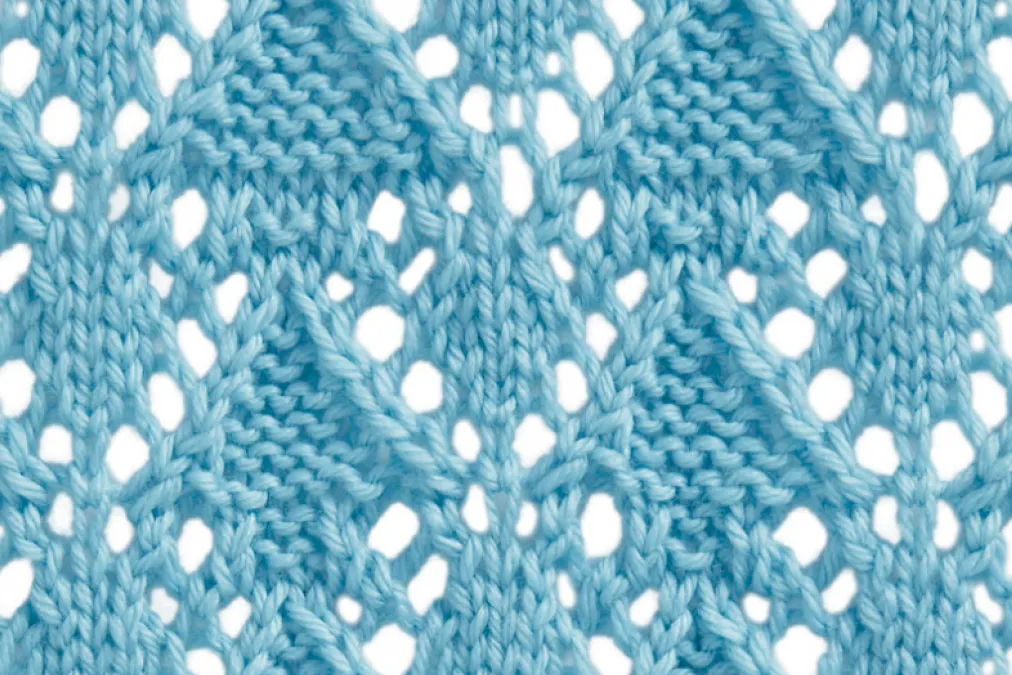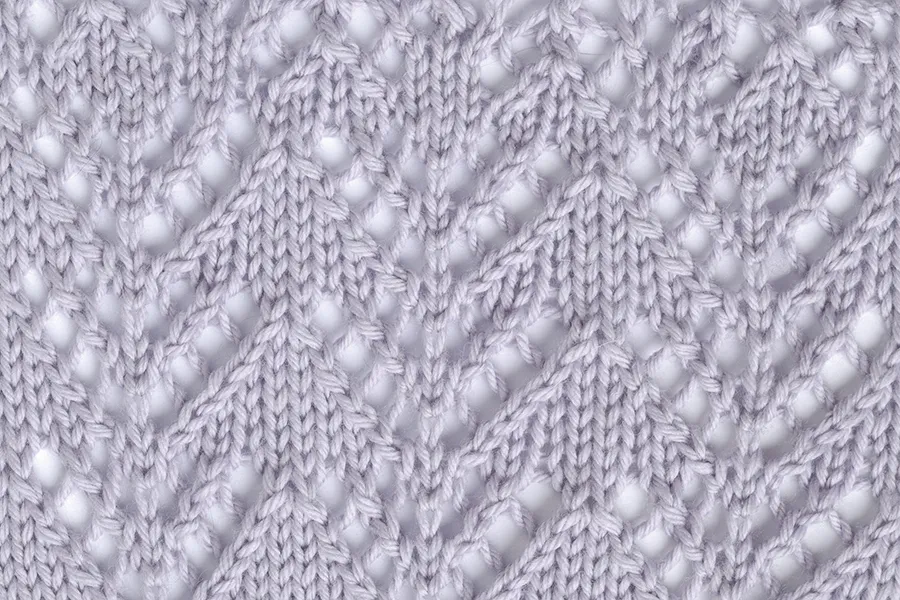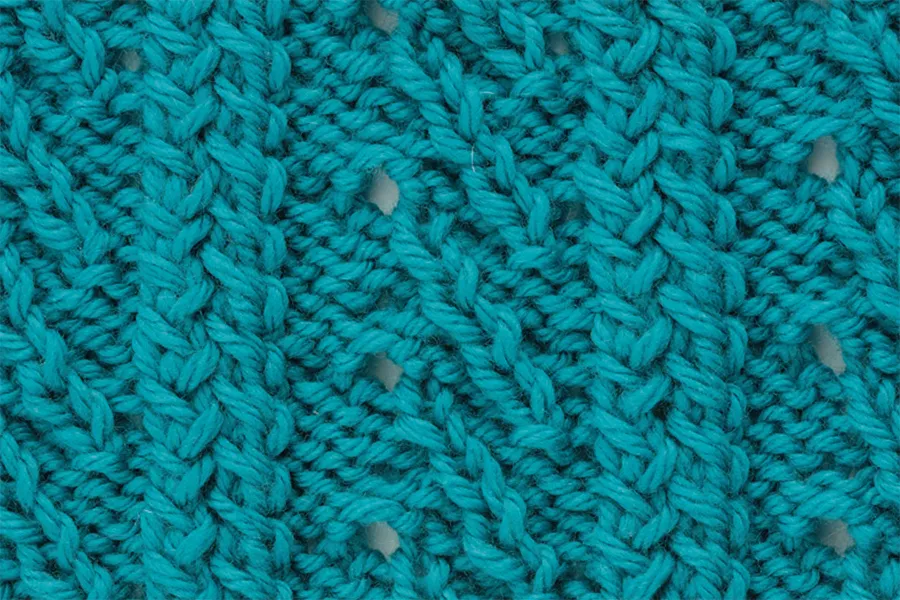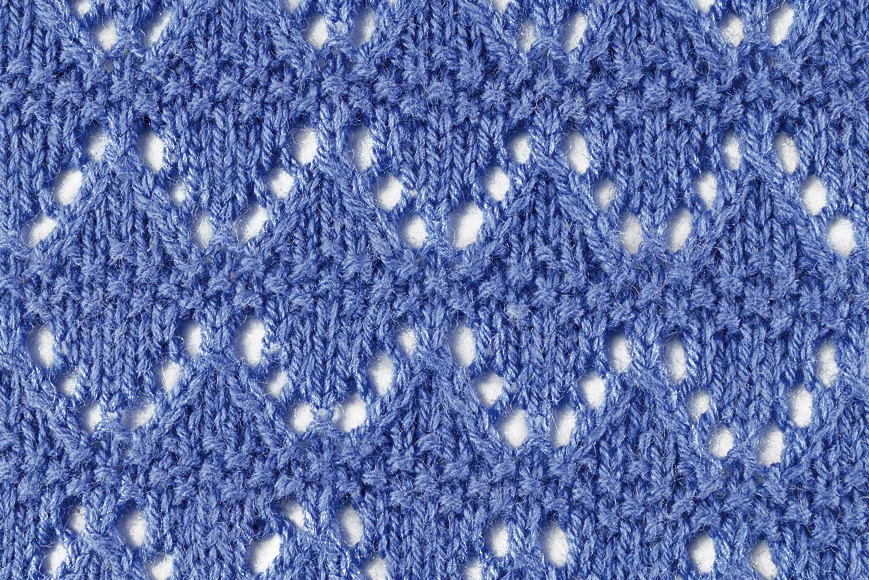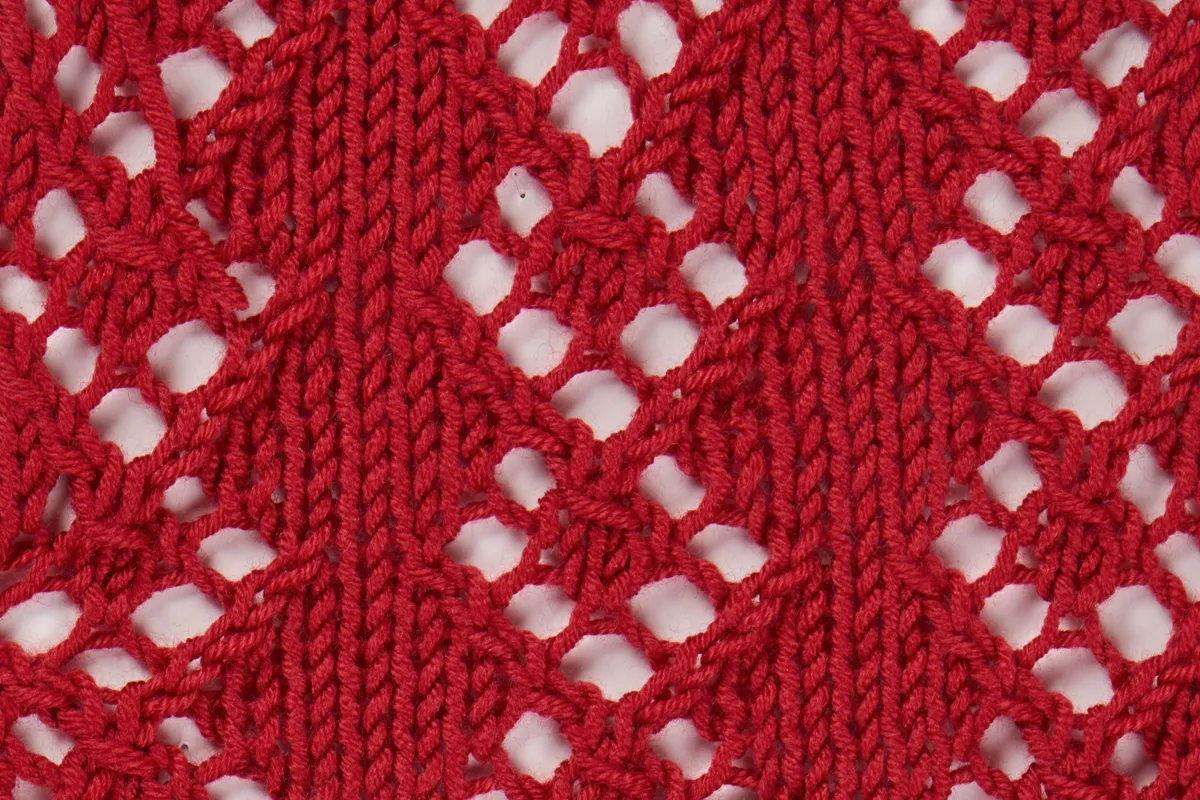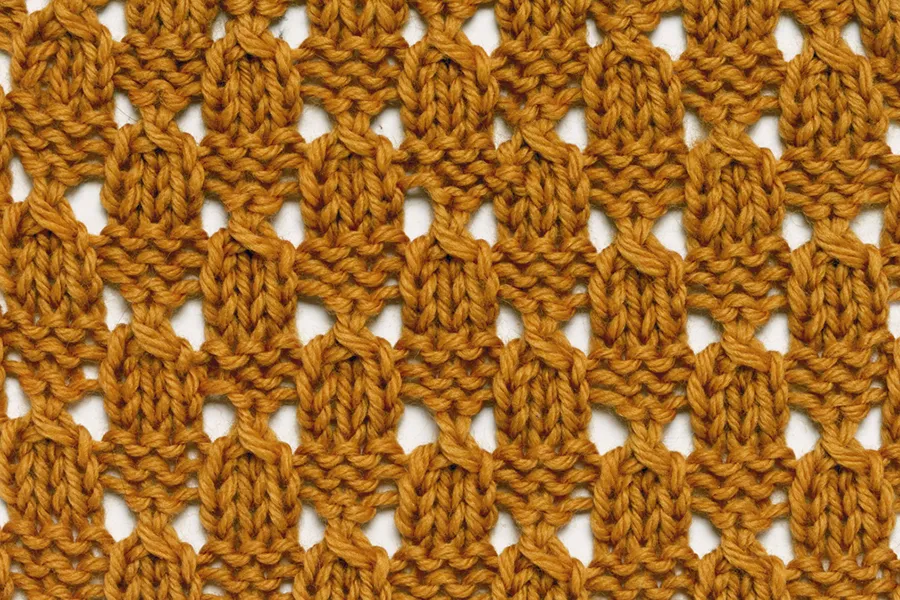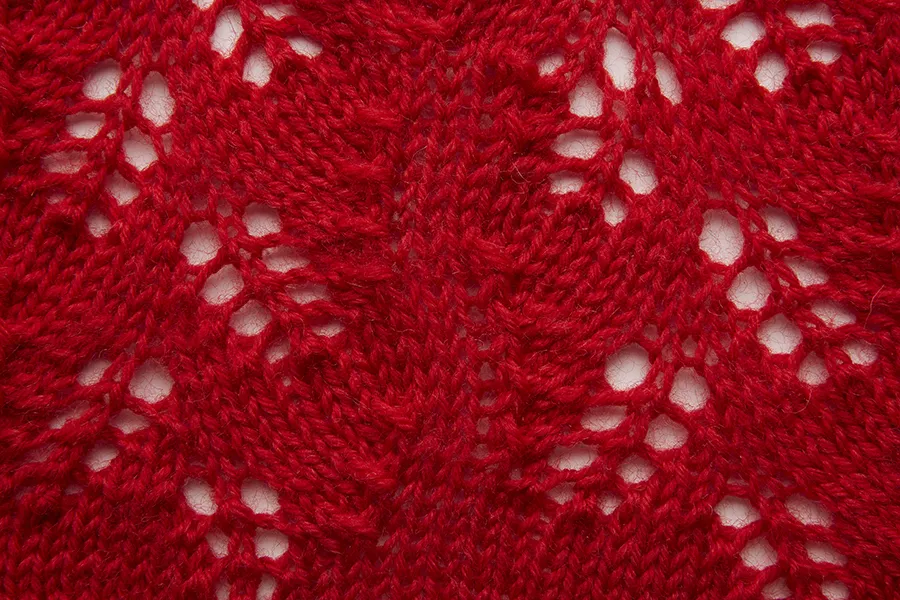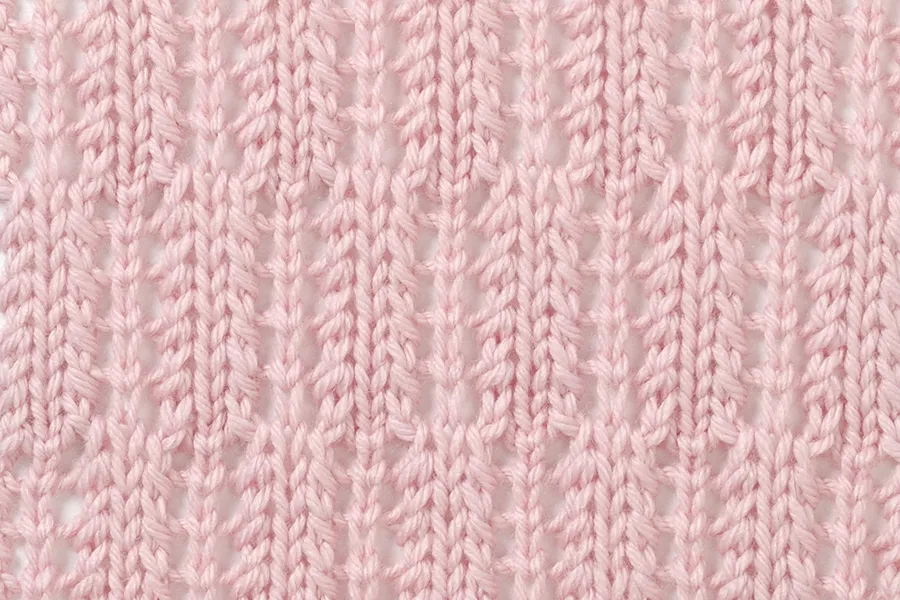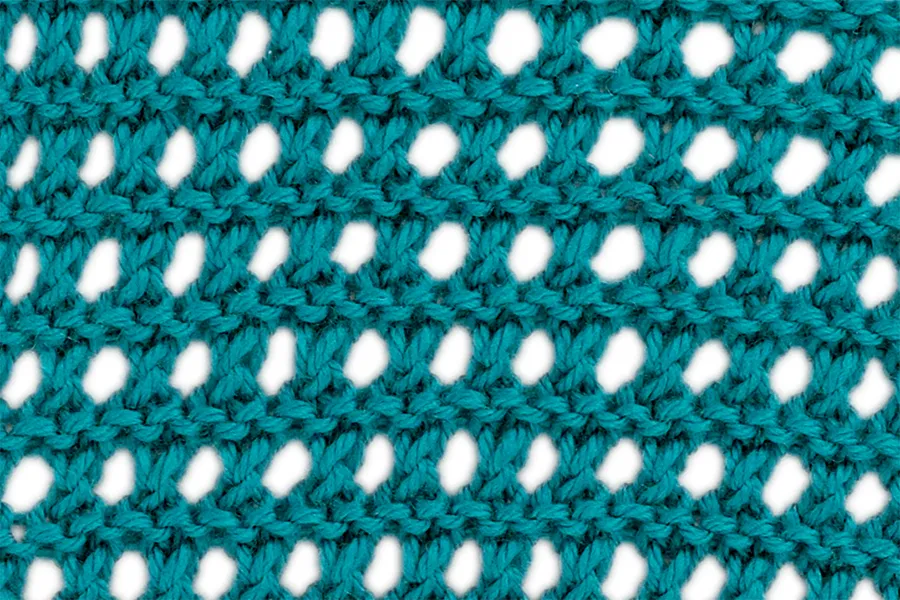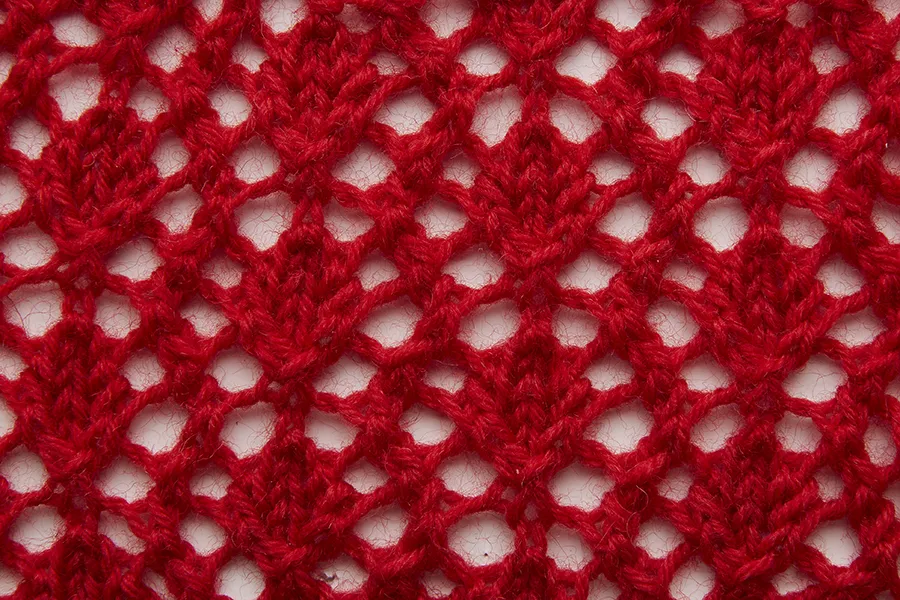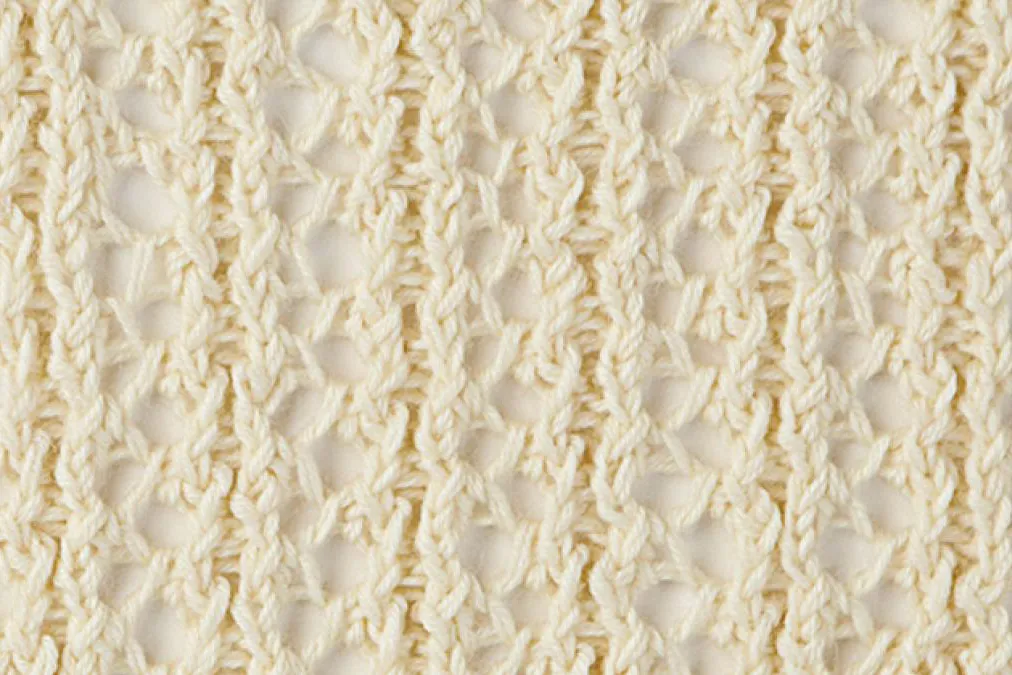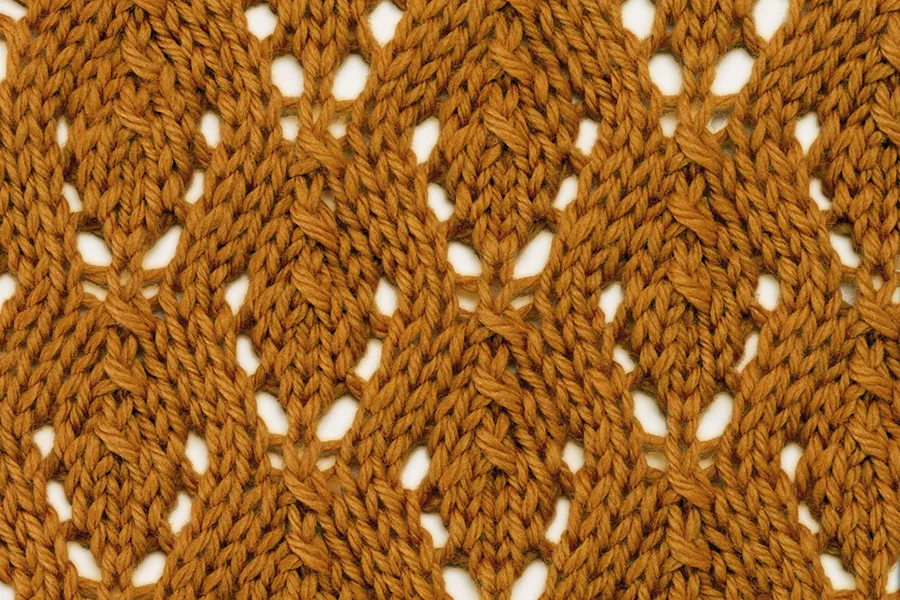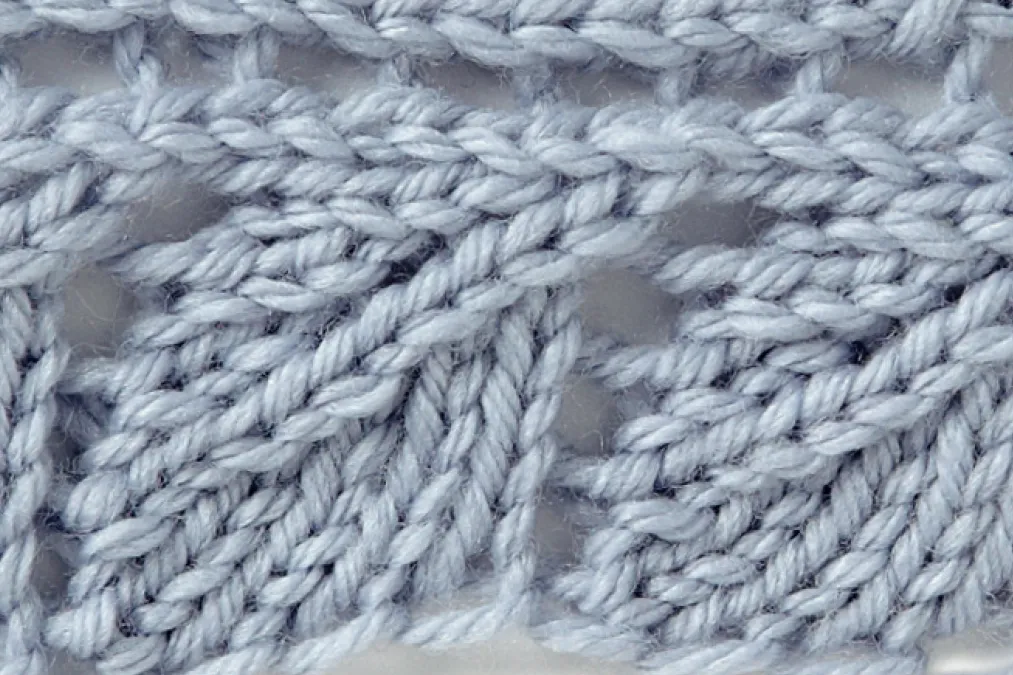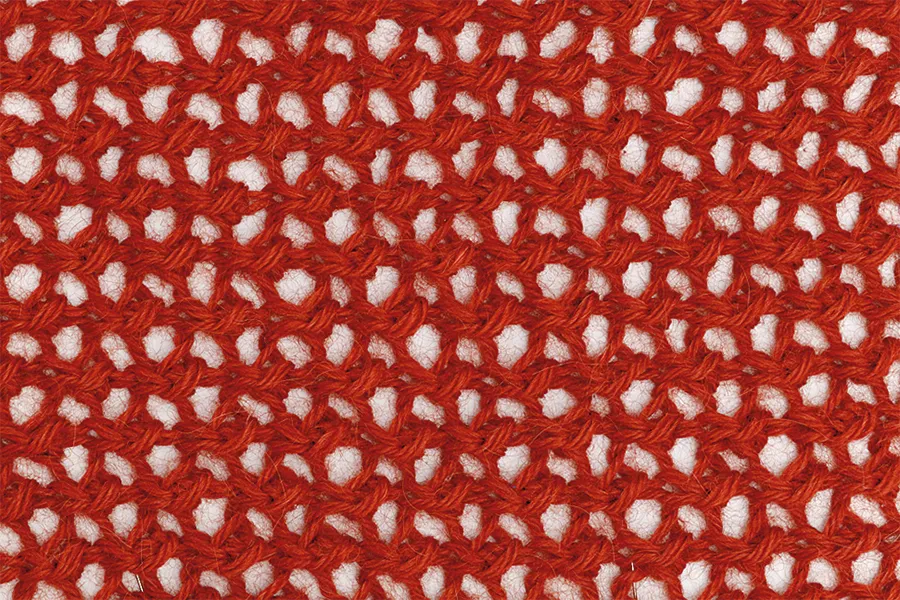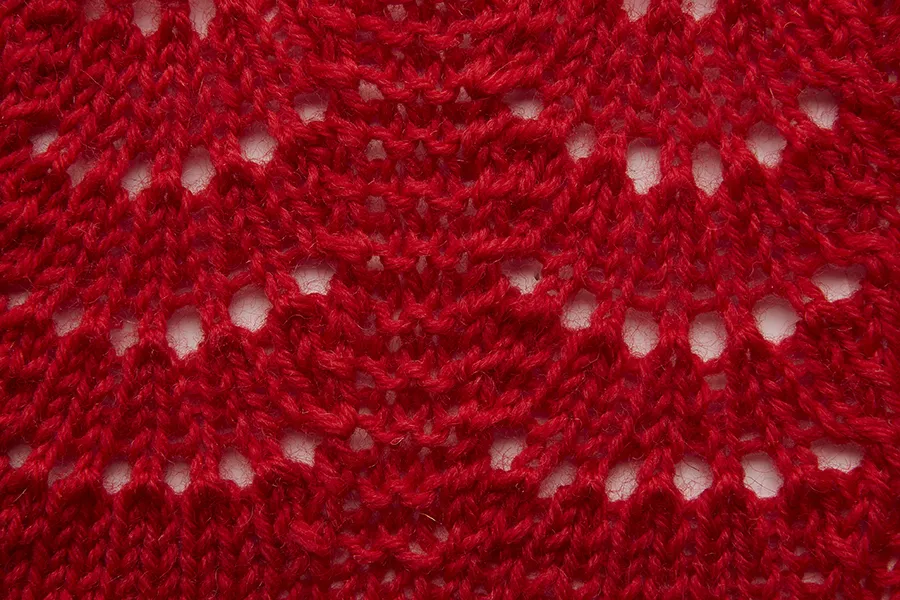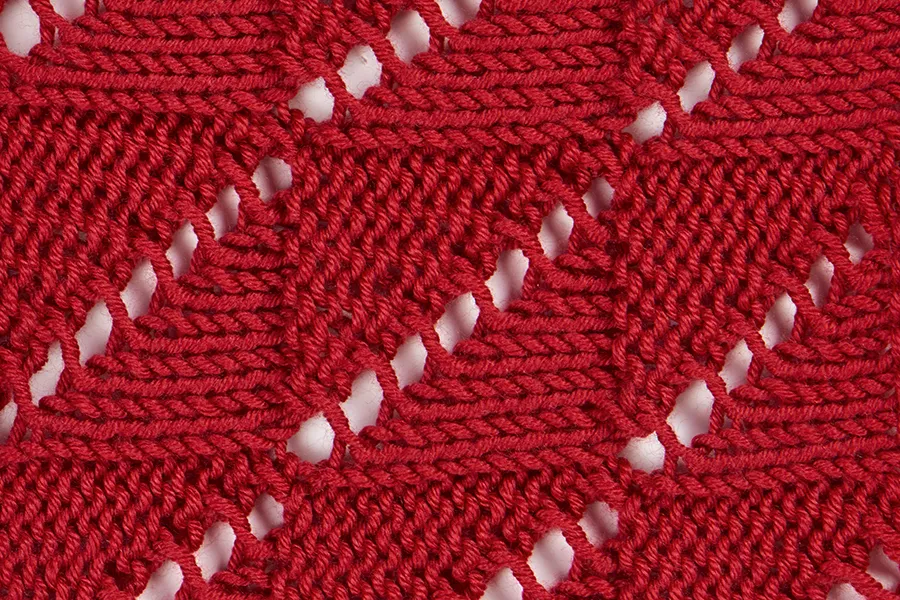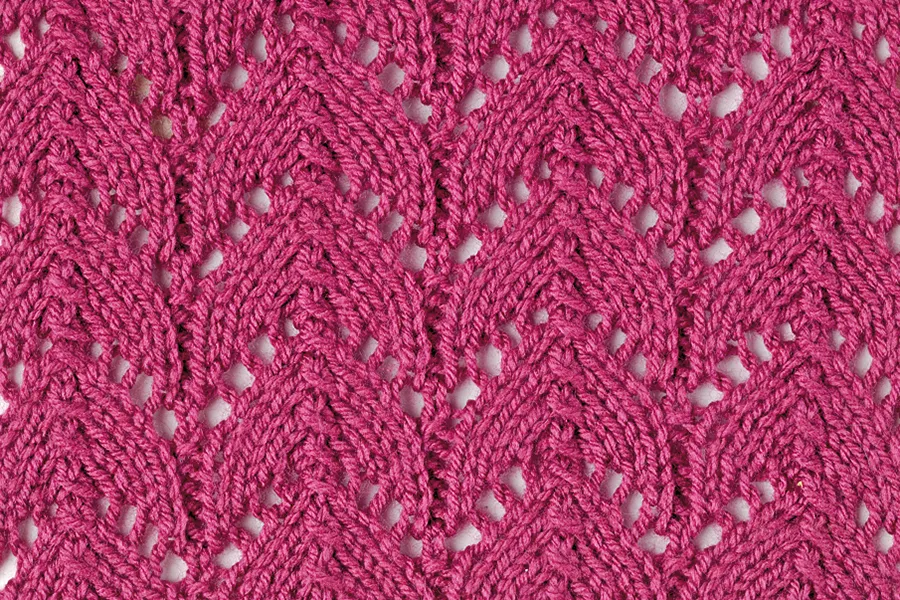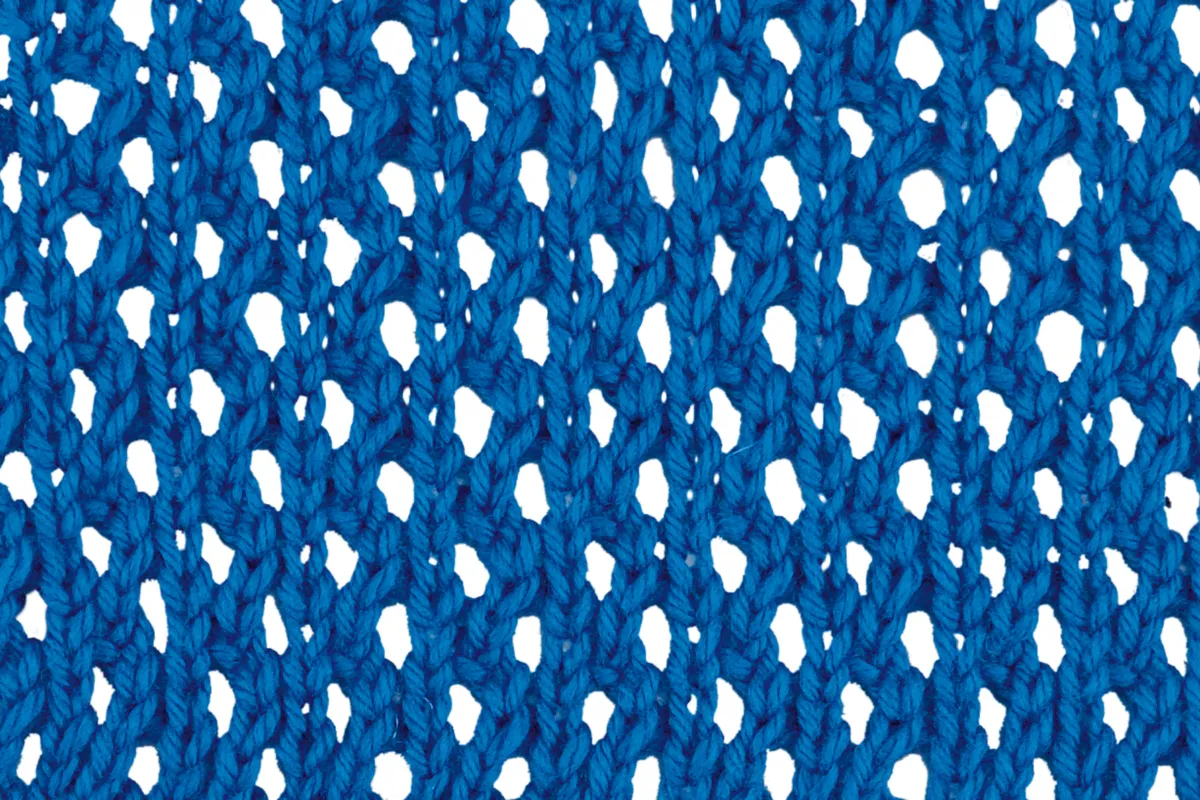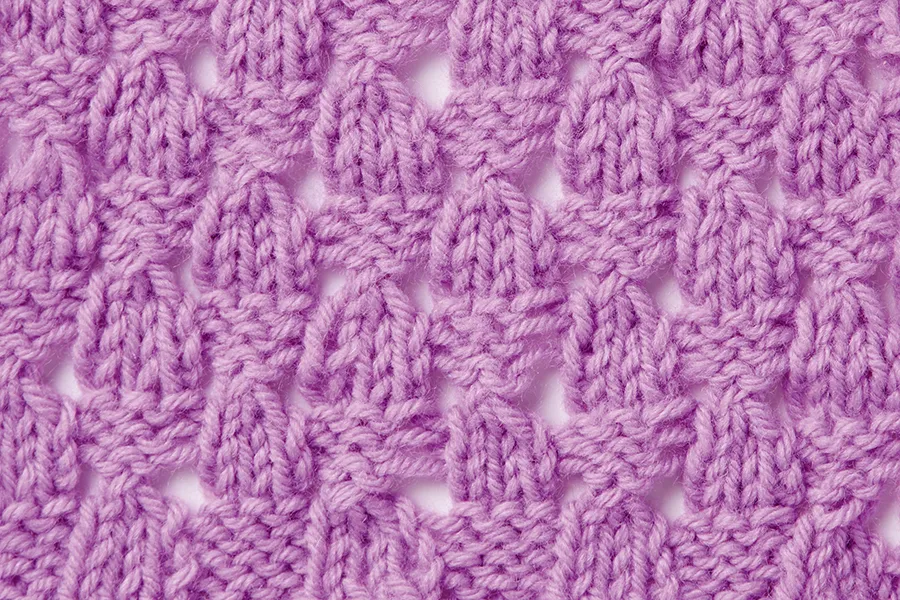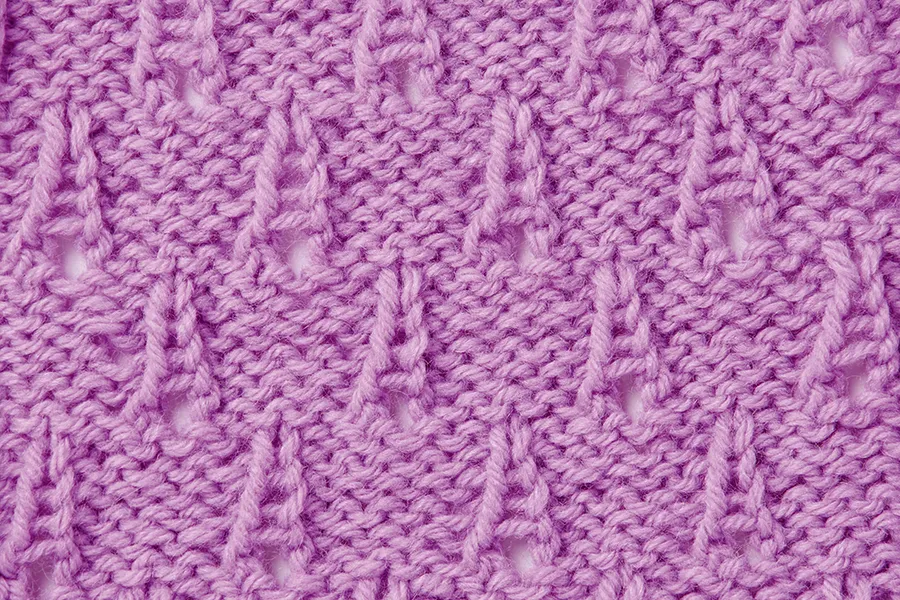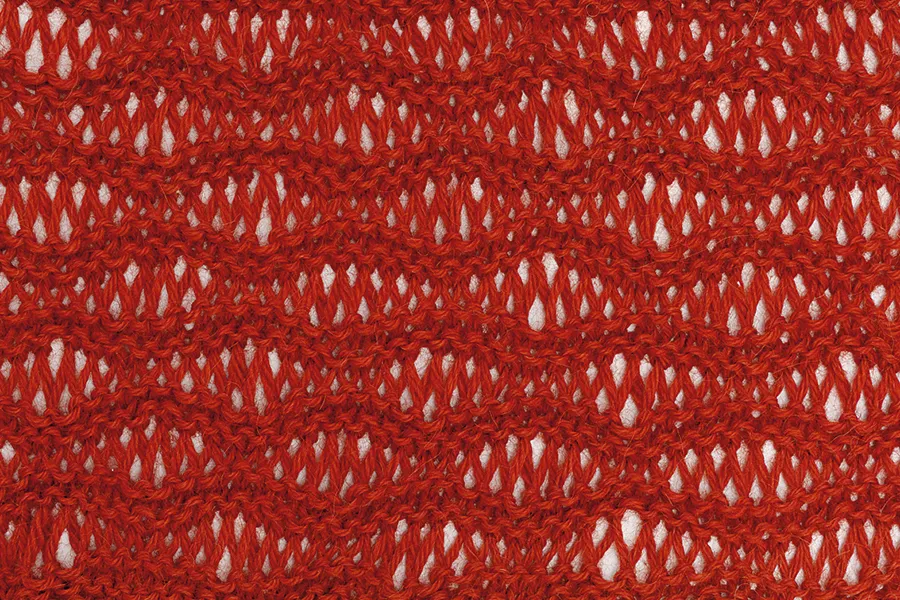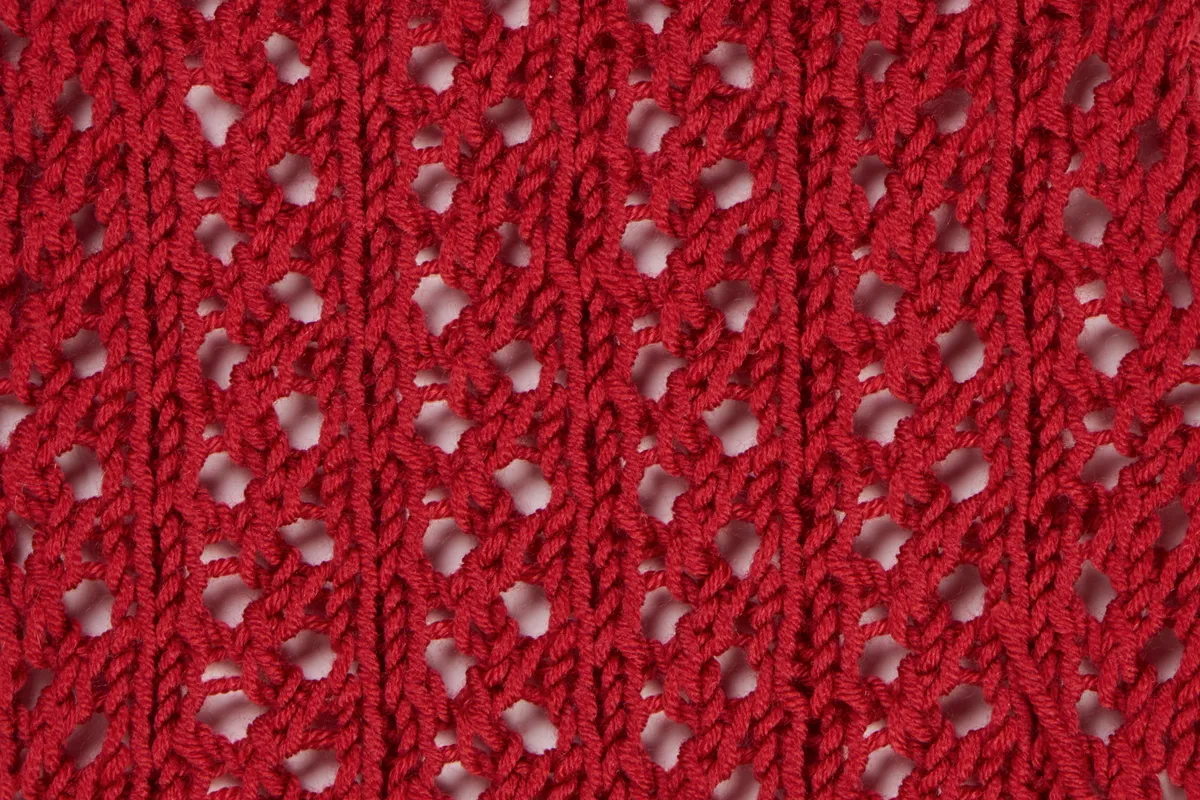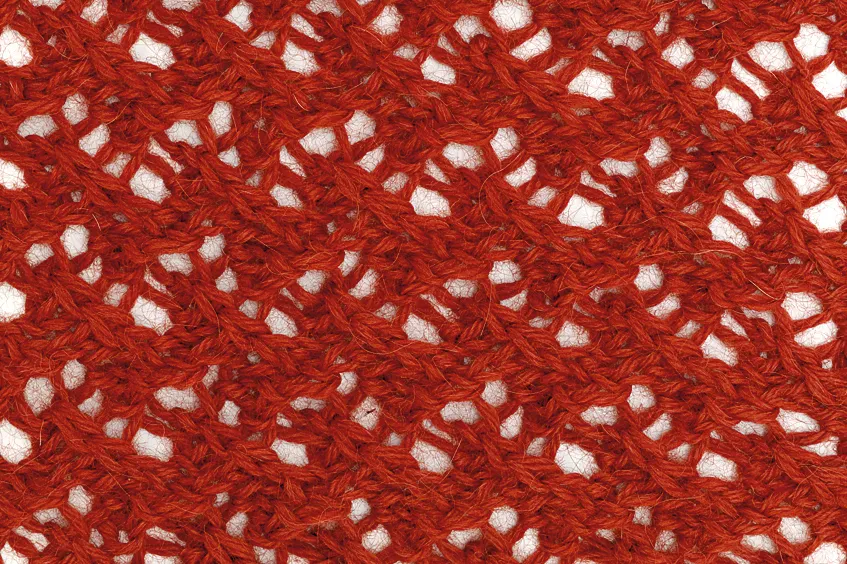Beginner's guide to lace knitting
ace knitting looks complex, with its delicate holes and patterns of shaping. But the secret is, it’s really not! Lace fabrics are created with simple increase and decrease stitches, many of which you’ll probably already know.
- 17 knit and purl patterns to try today
- Embellish your knits with Swiss darning
- How to Norwegian purl in knitting
In this beginner's guide, we'll introduce some of the most important stitches in lace knitting, recommend some needles and patterns to try, and share our library of lace knitting stitch patterns to inspire you.
Guide to lace knitting contents
- Lace knitting: all you need to know
- 3 Lace knitting tips
- Blocking lace knitting
- How to read lace knitting charts
- Stitch library: 23 lace knitting stitches
- The yo knitting stitch
- K2tog yo: how to knit 2 together yarn over
- Lace knitting needles: 3 to buy
- Lace knitting yarns: 3 to buy
- Easy lace knitting patterns: 3 to try
Lace knitting: all you need to know
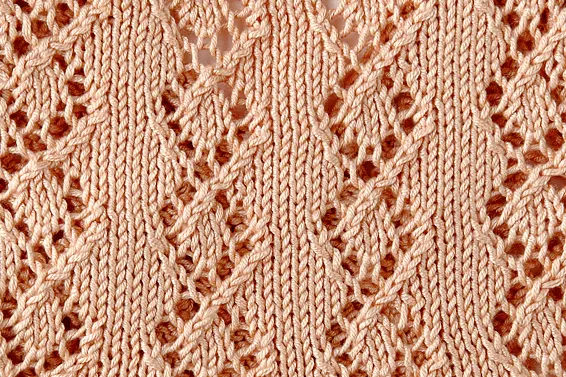
The most important stitch you’ll use in lace knitting is the yarn over. This increases the number of stitches on your needle by one, and also creates a hole in your fabric. Find out more about the yo knitting stitch below.
Decrease stitches generally slant either left (ssk) or right (k2tog). Lace knitting uses the lines created by these slants, along with the holes created by yarn overs, to create delicate patterns in the fabric.
There are a large number of decrease stitches you can choose from, each one creating a different finished look and effect – it’s the choice and arrangement of these decreases that creates the lace pattern.
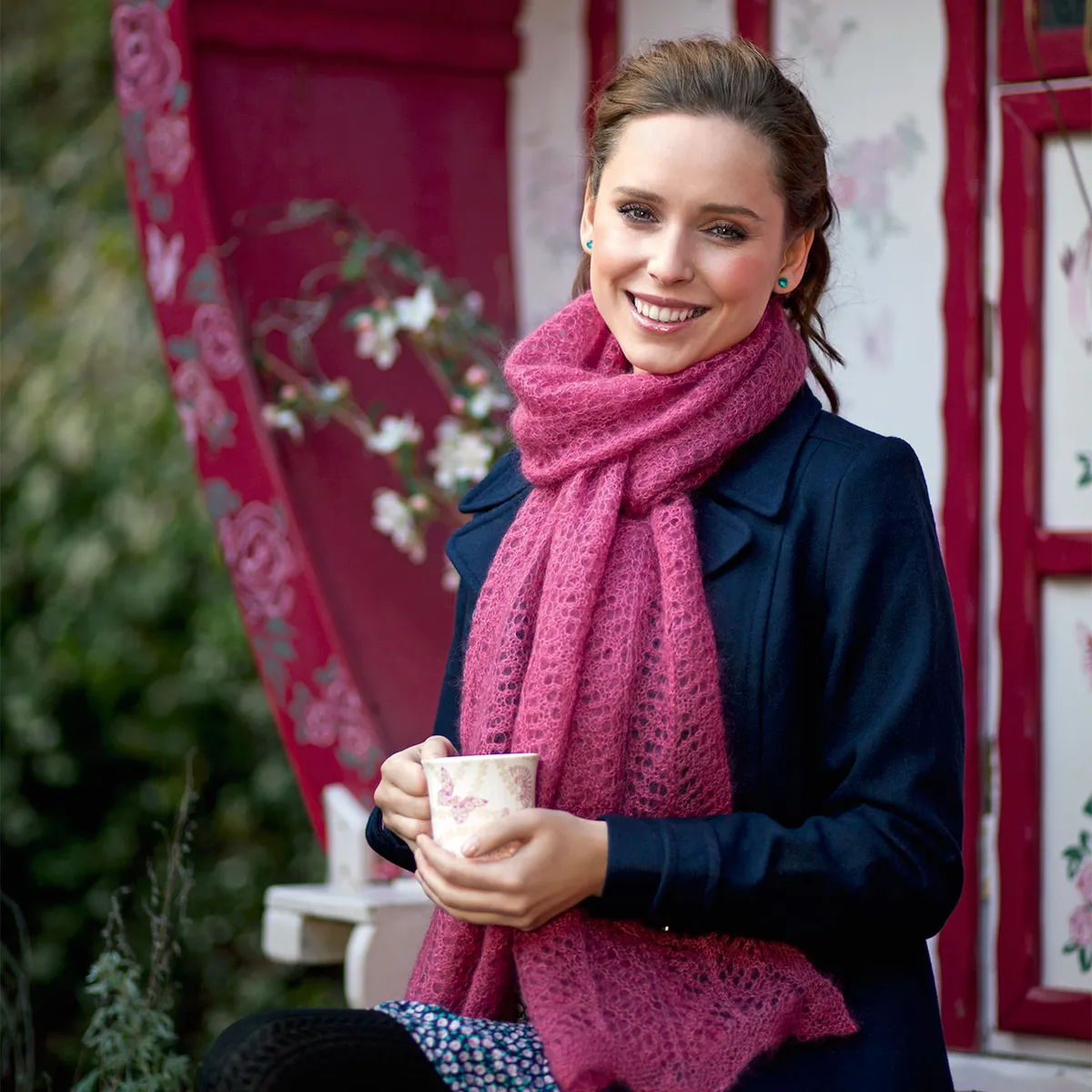
If you’re knitting a straight piece of fabric (such as a lace scarf) then every increase you make will need to be paired with a decrease, so the overall stitch count of your work doesn’t change. A yarn over may be paired with a k2tog, for example, or you may find two yarn overs matched with a double decrease stitch such as a k3tog.
In other patterns, you’ll need to change the stitch count of your work to shape the fabric – such as for a triangular shawl. This is easy to do when knitting lace because you’re already working with lots of increases and decreases, so you’ll often find that a design will ‘grow’ organically, within the pattern.
Lace designs can be formed in any type of knitted fabric, including stocking stitch and garter stitch – with stocking stitch being the most common.
On simple lace designs, the pattern is usually worked on the right-side (knit) rows only, while the wrong-side rows simply involve purling back across all your stitches. More advanced lace designs involve working the lace on both the right and wrong sides, but it’s best to get used to lace knitting before attempting these.

Knit yourself a new wardrobe with our online shop
Want to give your wardrobe a refresh and practice your knitting? Try one of the knitting patterns available to buy in our Online Shop, including this Boxy T-shirt Knitting Pattern PDF which is a total wardrobe staple.
3 Lace knitting tips
- If you have a lace pattern repeated across your work, use stitch markers in between each repeat. This way, you only have a few stitches to count at a time, and it’s easier to check for mistakes, too. Safety pin-style markers such as Knit Pro Locking Stitch Markers are ideal for lace.
- At the end of each row, count the stitches on your needles (or between each stitch marker). Gained or lost a stitch? It’s better to find out as soon as possible rather than two rows later when the stitches don’t line up! See our extra knitting lace tips and our lace knitting tutorial on how to avoid and fix mistakes.
- If you’re worried about mistakes or dropped stitches, work a knitting lifeline into your lace. Thread a long piece of spare yarn onto a tapestry needle and pass it through every stitch on a row. Continue knitting and if you make a big mistake, you can unravel back to the lifeline and place all the stitches back onto your needle.
Blocking lace knitting
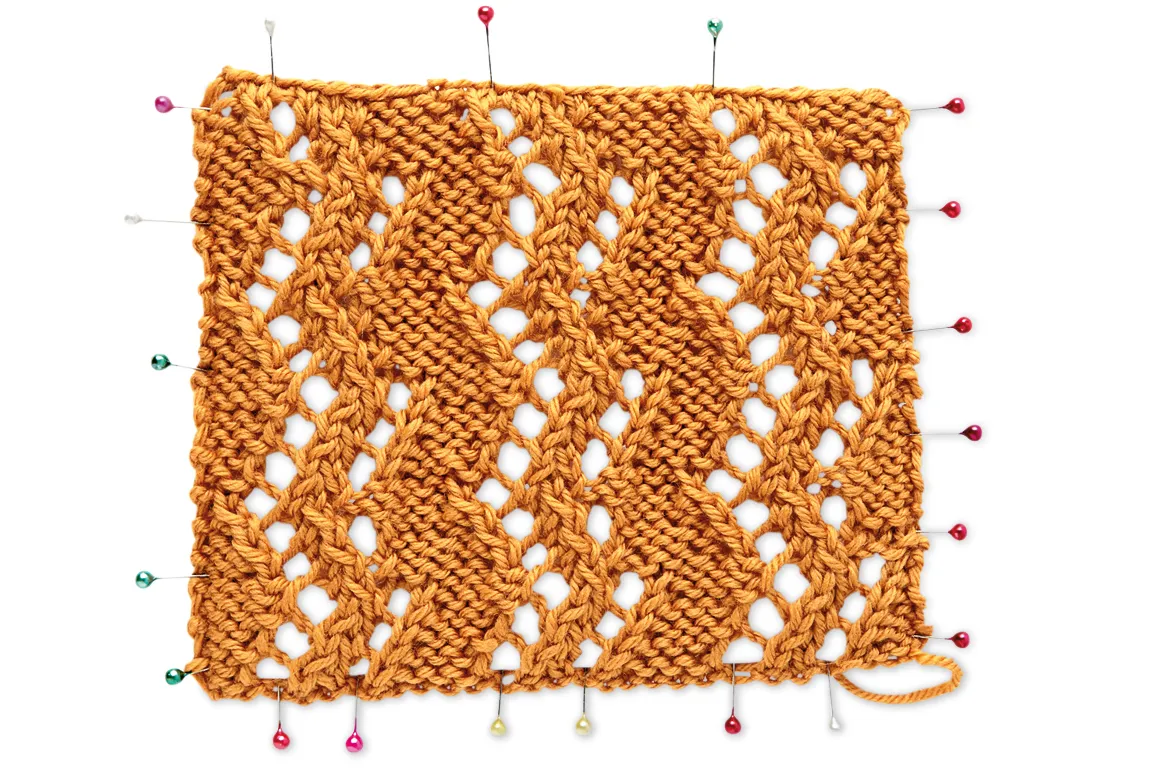
When you finish knitting your lace piece, don’t be discouraged if it looks small, scrunched up and nothing like the delicate, draping fabric you’d pictured – that’s totally normal!
It’s vital to gently wash and block your lace to open up the stitches and show off your finished piece. Blocking involves laying out the damp fabric on a mattress, thick carpet or foam blocking board, then gently stretching out the knitting and pinning down the edges so they don’t roll back. Once it’s dry, you can unpin and enjoy a beautifully lacy, perfectly finished project!
To see how it's done, check out our guides on how to block lace knitting.
How to read lace knitting charts
Some lace designs write out each stitch in the pattern for you to follow, while others use a lace knitting chart to show the stitches – some designs offer both, so you can choose which you prefer.
Different knitters prefer different instructions, but charts can really help you to understand the design and ‘read’ the knitting on your needles.
On lace charts, a yarn over is often represented as a circle, which matches up to a hole in your knitting, while decreases are usually shown as slanted lines, just like the decreases create slanted lines in your fabric. Looking at the chart can give you a good sense of how your lace is created and how it will look.
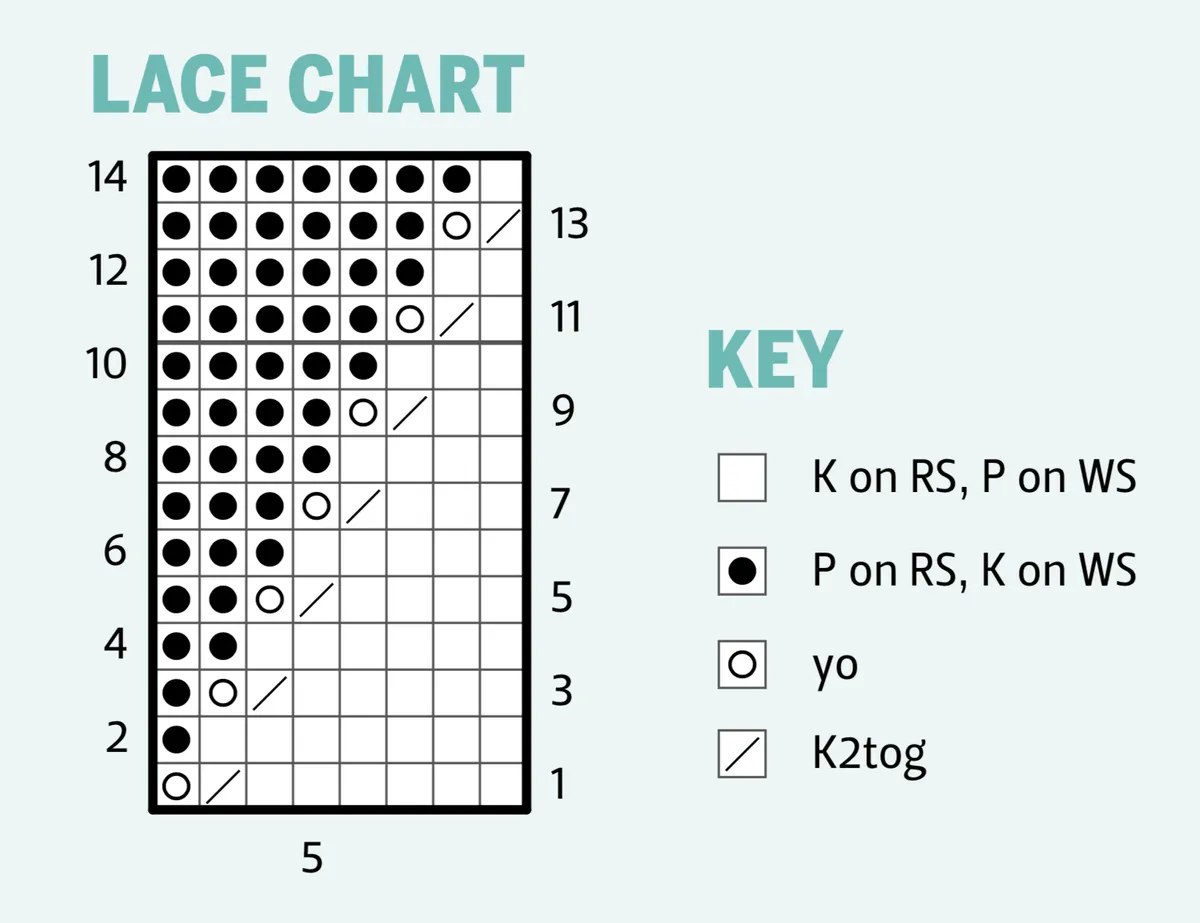
Lace patterns are often repeated across a panel of knitting, so lace charts will frequently just show one repeat of the pattern, which you can work as many times as instructed.
Often, lace designs are only worked on the knit side of stocking stitch fabric, so charts might show the wrong-side rows as all purl stitches or leave out these rows altogether. Before you start knitting, check the rows numbers given, as well as the instructions in the pattern and any notes next to the chart.
More complicated lace patterns will have a lace pattern used on both sides of the fabric. We recommend that you get used to working with lace patterns just on the right side of the fabric before trying these harder lace patterns.
- See our in-depth guide on how to read charts in knitting patterns.
Lace knitting stitches: stitch library
Be inspired by our collection of lace knitting stitches. From simple eyelet lace and netting to fancy diamond and lattice patterns, we have something for everyone in our library.
Use these stitches to create your own shawls, scarves and garments, or make a stitch sampler to boost your skills. If you like these, make sure you take a look at our full collection of knitting stitch patterns.
All of these stitch patterns use our standard knitting abbreviations. Here are the patterns you’ll find in our lace stitch library:
Arrowhead lace pattern
Cast on a multiple of 11 sts. (Try 44 sts.)
Row 1 (RS) *P3, k2tog, yo, K1, yo, ssk, P3; rep from * to end of row.
Row 2 and all alt rows Knit the knit sts, purl the purl sts and purl the yarn overs.
Row 3 *P2, k2tog, yo, K3, yo, ssk, P2; rep from * to end of row.
Row 5 *P1, k2tog, yo, K5, yo, ssk, P1; rep from * to end of row.
Row 7 *K2tog, yo, K1, yo, k2tog, K1, ssk, yo, K1, yo, ssk; rep from * to end of row.
Row 9 *P1, ssk, yo, k2tog, yo, K1, yo, ssk, yo, k2tog, P1; rep from * to end of row.
Row 10 Knit the knit sts and purl the purl sts and purl the yarn overs.
Repeat rows 1-10 to form the pattern.
Branching lace pattern
Cast on a multiple of 11 sts. (Try 44 sts.)
Row 1 (RS) *K3, k2tog, yo, K1, yo, ssk, K3; rep from * to end.
Rows 2, 4 & 6 Purl.
Row 3 *K2, k2tog, yo, K3, yo, ssk, K2; rep from * to end.
Row 5 *K1, (k2tog, yo) twice, K1, (yo, ssk) twice, K1; rep from * to end.
Row 7 *(K2tog, yo) twice, K3, (yo, ssk) twice; rep from * to end.
Row 8 Purl.
Repeat these 8 rows to desired length.
Crossed rib & lace pattern
Cast on a multiple of 12 sts plus 1 st. (Try 49 sts.)
Row 1 (RS) P1, *CO, P1, K1, P6; rep from * to end.
Row 2 *Knit the knit sts; purl the purl sts; rep from * to end.
Row 3 P1, *CO, P1, LC, P5; rep from * to end.
Row 4 Repeat as Row 2.
Row 5 P1, *CO, P2, LC, P4; rep from * to end.
Row 6 Repeat as row 2.
Row 7 P1, *CO, P1, K1, P1, LC, P3; rep from * to end.
Row 8 Repeat as Row 2.
Row 9 P1, *CO, P1, LC, P2, yo, p2tog, P1; rep from * to end.
Row 10 *Knit the knit sts; purl the purl sts and purl the yo; rep from * to end.
Rep Rows 5-10 to form pattern.
Abbreviations
CO (cable over) slip 1 stitch to cable needle and hold in front, K1, K1 from cable needle, skip 1 stitch on left needle, K1, knit the skipped stitch, dropping the stitches from the left needle
LC (left cross) slip 1 stitch to cable needle and hold in front, P1, K1 from cable needle
Diamonds in moss lace pattern
Cast on a multiple of 8 sts plus 1. (Try 41 sts.)
Row 1 (RS) K1, *P1, K1; rep from * to end.
Rep the last row 3 times more to form moss stitch.
Row 5 K1, *yo, sl 1, K1, psso, K3, k2tog, yo, K1; rep from * to end.
Rows 6, 8, 10, 16, 18 & 20 Purl.
Row 7 K2, *yo, sl 1, K1, psso, K1, k2tog, yo, K3; rep from * to last 7 sts, yo, sl 1, K1, psso, K1, k2tog, yo, K2.
Row 9 K3, *yo, sl 1, k2tog, psso, yo, K5; rep from * to last 6 sts, yo, sl 1, k2tog, psso, yo, K3.
Row 11 K1, *P1, K1; rep from * to end.
Rep last row 3 times more.
Row 15 K2, *k2tog, yo, K1, yo, sl 1, K1, psso, K3; rep from * to last 7 sts, k2tog, yo, K1, yo, sl 1, K1, psso, K2.
Row 17 *K1, k2tog, yo, K3, yo, sl 1, K1, psso; rep from * to last st, K1.
Row 19 K2tog, *yo, K5, yo, sl 1, k2tog, psso; rep from * to last 7 sts, yo, K5, yo, sl 1, K1, psso.
Repeat these 20 rows to desired length.
Diamond lattice lace pattern
Cast on a multiple of 8 sts.
Row 1 (RS) *K3, yo, sl1, K2, psso, yo, K2; rep from * to end.
Row 2 Purl.
Row 3 *K3, k2tog, yo, ssk, K2; rep from * to end.
Row 4 Purl.
Row 5 *K2, k2tog, yo, K1, yo, ssk, K1; rep from * to end.
Row 6 Purl.
Row 7 *K1, k2tog, yo, K3, yo, ssk; rep from * to end.
Row 8 Purl.
Rows 1–8 form pattern.
Eyelet weave lace pattern
Cast on a multiple of 6 sts plus 1. (Try 49 sts.)
Row 1 (WS) K2, * P3, K3, rep from * to last 5 sts, P3, K2.
Row 2 P2, * K3, P3; rep from * to last 5 sts, K3, P2.
Row 3 K2, * P3, K3; rep from * to last 5 sts, P3, K2.
Row 4 K2, * yo, sk2po, yo, K3; rep from * to last 5 sts, yo, sk2po, yo, K2.
Row 5 P2, * K3, P3; rep from * to last 5 sts, K3, P2.
Row 6 K2, * P3, K3; rep from * to last 5 sts, P3, K2.
Row 7 P2, * K3, P3; rep from * to last 5 sts, K3, P2.
Row 8 K2tog, * yo, K3, yo, sk2po; rep from * to last 5 sts, yo, K3, yo, sl 1, K1, psso.
Repeat these 8 rows to desired length.
Falling eyelets lace pattern
Cast on a multiple of 18 sts plus 2.
Row 1 *K11, yo, K1, yo, K3, sl1, k2tog, psso; rep from * to last 2 sts, K2.
Row 2 and all even rows Knit the knit sts and purl the purl sts and yarn overs.
Row 3 *K12, yo, K1, yo, K2, sl1, k2tog, psso; rep from * to last 2 sts, K2.
Row 5 *K2, sl1, k2tog, psso, K4, yo, K1, yo, K3, yo, K1, yo, K1, sl1, k2tog, psso; rep from * to last 2 sts, K2.
Row 7 *K2, sl1, k2tog, psso, K3, yo, K1, yo, K9; rep from * to last 2 sts, K2.
Row 9 K2, sl1, k2tog, psso, K2, yo, K1, yo, K10; rep from * to last 2 sts, K2.
Row 11 K2, sl1, k2tog, psso, K1, yo, K1, yo, K3, yo, K1, yo, K4, sl1, k2tog, psso; rep from * to last 2 sts, K2.
Row 12 Knit the knit sts and purl the purl sts and yarn overs.
Rows 1–12 form pattern.
Feathery lace pattern
Cast on a multiple of 6 sts plus 1. (Try 43 sts.)
Row 1 (RS) K1, *k2tog, yo, K1, yo, sl 1, K1, psso, K1; rep from * to end.
Row 2 Purl.
Rep these 2 rows 5 times more.
Row 13 K1, *yo, sl 1, K1, psso, K1, k2tog, yo, K1; rep from * to end.
Row 14 Purl.
Rep the last 2 rows 5 times more.
Repeat these 24 rows to desired length.
Horizontal eyelet lace pattern
Cast on an odd number of stitches. (Try 41 sts.)
Row 1 (WS) Knit.
Row 2 Knit.
Row 3 K1, P1, *yo, p2tog; rep from * to last st, K1.
Row 4 Knit.
Repeat these 4 rows to desired length.
Lacy diamonds lace pattern
Cast on a multiple of 10 sts plus 6.
Row 1 (RS) K1, yo, ssk, yo, *ssk, K1, k2tog, yo, k2tog, yo, K1, yo, ssk, yo; rep from * to last 3 sts, ssk, K1.
Row 2 and all even rows Purl.
Row 3 K2, yo, ssk, yo, *sskpo, yo, k2tog, yo, K3, yo, ssk, yo; rep from * to last 2 sts, ssk.
Row 5 K1, k2tog, yo, k2tog, *yo, K1, yo, ssk, yo, ssk, K1, k2tog, yo, k2tog; rep from * to last st, yo, K1.
Row 7 K2tog, yo, k2tog, *yo, K3, yo, ssk, yo, sskpo, yo, k2tog; rep from * to last 2 sts, yo, K2.
Row 8 Purl.
Rows 1–8 form pattern.
Abbreviations
sskpo ssk, place this st back on LH needle. Lift 2nd st on LH needle over the ssk st, then return the ssk st to RH needle
Lacy pillars lace pattern
Cast on a multiple of 10 stitches. (Try 40 sts.)
Row 1 (RS) *P1, ssk, K1, yo, K1, p1, K1, yo, K1, k2tog; rep from * to end.
Row 2 (WS) *P2tog, P1, yo, P1, K1, P1, yo, P1, p2tog tbl, K1; rep from * to end.
Row 3 *P1, ssk, K1, yo, K1, P1, K1, yo, K1, k2tog; rep from * to end.
Row 4 *P1, yo, P1, p2tog tbl, K1, p2tog, P1, yo, P1, K1; rep from * to end.
Row 5 *P1, K1, yo, K1, k2tog, P1, ssk, K1, yo, K1; rep from * to end.
Row 6 *P2tog, P1, yo, P1, K1, P1, yo, P1, p2tog tbl, K1; rep from * to end.
Rows 3-6 form the pattern.
Leaf & weave lace pattern
Cast on a multiple of 12 sts plus 1. (Try 49 sts.)
Row 1 (RS) K2tog, K4, yo, K1, yo, K4, *sk2po, K4, yo, K1, yo, K4; rep from * to last 2 sts, sl 1, K1, psso.
Row 2 and every alt row Purl.
Row 3 K2tog, K3, (yo, K3) twice, *sk2po, K3, (yo, K3) twice; rep from * to last 2 sts, sl 1, K1, psso.
Row 5 K2tog, K2, yo, K5, yo, K2, *sk2po, K2, yo, K5, yo, K2; rep from * to last 2 sts, sl 1, K1, psso.
Row 7 K1, * yo, K4, sk2po, K4, yo, K1; rep from * to end.
Row 9 K2, yo, K3, sk2po, K3, *(yo, K3) twice, sk2po, K3; rep from * to last 2 sts, yo, K2.
Row 11 K3, yo, K2, sk2po, K2, *yo, K5, yo, K2, sk2po, K2; rep from * to last 3 sts, yo, K3.
Row 12 Purl.
Repeat these 12 rows to desired length.
Leafy edging lace pattern
Cast on 12 sts.
Row 1 (RS) Yo, K1, yo, K2, (k2tog) twice, K2, yo, k2tog, K1.
Row 2 and every alt row Purl.
Row 3 Yo, K3, yo, K1, (k2tog) twice, K1, yo, k2tog, K1.
Row 5 Yo, K5, yo, (k2tog) twice, yo, k2tog, K1.
Row 7 Yo, K3, k2tog, K2, yo, k2tog, yo, k2tog, K1.
These 8 rows form the pattern.
Netting lace pattern
Cast on a multiple of 4 sts plus 3. (Try 47 sts.)
Row 1 (RS) K1, yo, sl 1, k2tog, psso, *yo, K1, yo, sl 1, k2tog, psso; rep from * to last 3 sts, yo, sl 1, K1, psso, yo, K1.
Row 2 Purl.
Row 3 K1, yo, k2tog, *yo, sl 1, k2tog, psso, yo, K1; rep from * to end of row.
Row 4 Purl.
Rows 1–4 form pattern.
Open flares lace pattern
Cast on a multiple of 11 sts plus 2.
Row 1 (RS) *P2, k2tog, (yo, K1) 5 times, yo, ssk; rep from * to last 2 sts, P2.
Row 2 and all even rows K2, purl to last 2 sts, K2.
Row 3 *P2, k2tog, K9, ssk; rep from * to last 2 sts, P2.
Row 5 *P2, k2tog, K7, ssk; rep from * to last 2 sts, P2.
Row 6 K2, purl to last 2 sts, K2.
Rows 1–6 form pattern.
Rising lines lace pattern
Cast on a multiple of 8 sts plus 1.
Row 1 (RS) *K6, k2tog, yo; rep from * to last st, K1.
Row 2 P1, *K1, P7; rep from * to end.
Row 3 *K5, k2tog, yo, P1; rep from * to last st, K1.
Row 4 P1, *K2, P6; rep from * to end.
Row 5 *K4, k2tog, yo, P2; rep from * to last st, K1.
Row 6 P1, *K3, P5; rep from * to end.
Row 7 *K3, k2tog, yo, P3; rep from * to last st, K1.
Row 8 P1, *K4, P4; rep from * to end.
Row 9 *K2, k2tog, yo, P4; rep from * to last st, K1.
Row 10 P1, *K5, P3; rep from * to end.
Row 11 *K1, k2tog, yo, P5; rep from * to last st, K1.
Row 12 P1, *K6, P2; rep from * to end.
Row 13 *K2tog, yo, P6; rep from * to last st, K1.
Row 14 P1, *K7, P1; rep from * to end.
Rows 1–14 form pattern.
Seashells lace pattern
Cast on a multiple of 10 sts plus 1. (Try 41 sts.)
Row 1 (WS) Purl.
Row 2 K1, *yo, K3, sk2po, K3, yo, K1; rep from * to end.
Row 3 Purl.
Row 4 P1, *K1, yo, K2, sk2po, K2, yo, K1, P1; rep from * to end.
Row 5 K1, *P9, K1; rep from * to end.
Row 6 P1, *K2, yo, K1, sk2po, K1, yo, K2, P1; rep from * to end.
Row 7 As row 5.
Row 8 P1, *K3, yo, sk2po, yo, K3, P1; rep from * to end.
Repeat these 8 rows to desired length.
Slip stitch netting lace pattern
Cast on a multiple of 3 sts. (Try 42 sts.)
Row 1 K2, *yo, sl 1, K2, psso both sts; rep from * to last st, K1.
Row 2 Purl.
Row 3 K1, *sl 1, K2, psso both sts, yo; rep from * to last 2 sts, K2.
Row 4 Purl.
Repeat these 4 rows to desired length.
Soft lattice lace pattern
Cast on a multiple of 6 sts plus 2.
Row 1 (RS) K1, *K3, P3; rep from * to last st, K1.
Row 2 and all alt rows K the K sts, P the P sts, K the yo loops.
Row 3 K1, *K3, P3; rep from * to last st, K1.
Row 5 K1, *yo, k3tog, yo, K3; rep from * to last st, K1.
Row 7 K1, *P3, K3; rep from * to last st, K1.
Row 9 K1, *K3, yo, k3tog, yo; rep from * to last st, K1.
Row 10 K the K sts, P the P sts, K the yo loops.
Rep rows 3–10 to form pattern.
Tiny triangles lace pattern
Cast on a multiple of 6 sts.
Row 1 (RS) *P4, yo, p2tog; rep from * to end.
Row 2 K1, *P1, K5; rep from * to last 5 sts, P1, K4.
Row 3 P4, *K1, P5; rep from * to last 2 sts, K1, P1.
Row 4 K1, *P1, K5; rep from * to last 5 sts, P1, K4.
Row 5 P4, *K1, P5; rep from * to last 2 sts, K1, P1.
Row 6 K1, *P1, K5; rep from * to last 5 sts, P1, K4.
Row 7 P1, *yo, p2tog, P4; rep from * to last 5 sts, yo, p2tog, P3.
Row 8 K4, *P1, K5; rep from * to last 2 sts, P1, K1.
Row 9 P1, *K1, P5; rep from * to last 5 sts, K1, P4.
Row 10 K4, *P1, K5; rep from * to last 2 sts, P1, K1.
Row 11 P1, *K1, P5; rep from * to last 5 sts, K1, P4.
Row 12 K4, *P1, K5; rep from * to last 2 sts, P1, K1.
Rep rows 1–12 to form pattern.
Waves lace pattern
Cast on a multiple of 8 sts plus 2. (Try 50 sts.)
Row 1 Knit.
Row 2 Knit.
**Row 3 Knit.
Row 4 Knit.
Row 5 K2, *KW2, KW2, KW3, KW3, KW2, KW2, K1, K1; rep from * to end of row.
Row 6 Knit all sts, dropping the extra loops.
Row 7 Knit.
Row 8 Knit.
Row 9 KW3, KW3, *KW2, KW2, K1, K1, KW2, KW2, KW3, KW3; rep from * to end of row.
Row 10 Knit all sts, dropping the extra loops.**
Repeat from ** to ** to form the pattern.
Abbreviations
KW2 knit the stitch, wrapping the yarn round the needle twice
KW3 knit the stitch, wrapping the yarn round the needle three times
Zigs & zags lace pattern
Cast on a multiple of 10 sts plus 1.
Row 1 (RS) P1, *K1, yo, k2tog, K1, P1, K1, ssk, yo, K1, P1; rep from * to end.
Row 2 *K1, P4; rep from * to last st, K1.
Row 3 P1, *K1, ssk, yo, K1, P1, K1, yo, k2tog, K1, P1; rep from * to end.
Row 4 *K1, P4; rep from * to last st, K1. Rows 1–4 form pattern.
Zig zag lace pattern
Cast on a multiple of 4 sts plus 1. (Try 45 sts.)
Row 1 K1, *yo, k2tog, K2; rep from * to end of row.
Row 2 P1, *p2tog, yo, P2; rep from * to end of row.
Row 3 K3, *yo, k2tog, K2; rep from * to last 2 sts, yo, k2tog.
Row 4 P1, *yo, p2tog, P2; rep from * to end of row.
Row 5 K1, *k2tog, yo, K2; rep from * to end of row.
Row 6 P3, *yo, p2tog, P2; rep from * to last 2 sts, yo, p2tog.
Rows 1–6 form pattern.
The yo knitting stitch
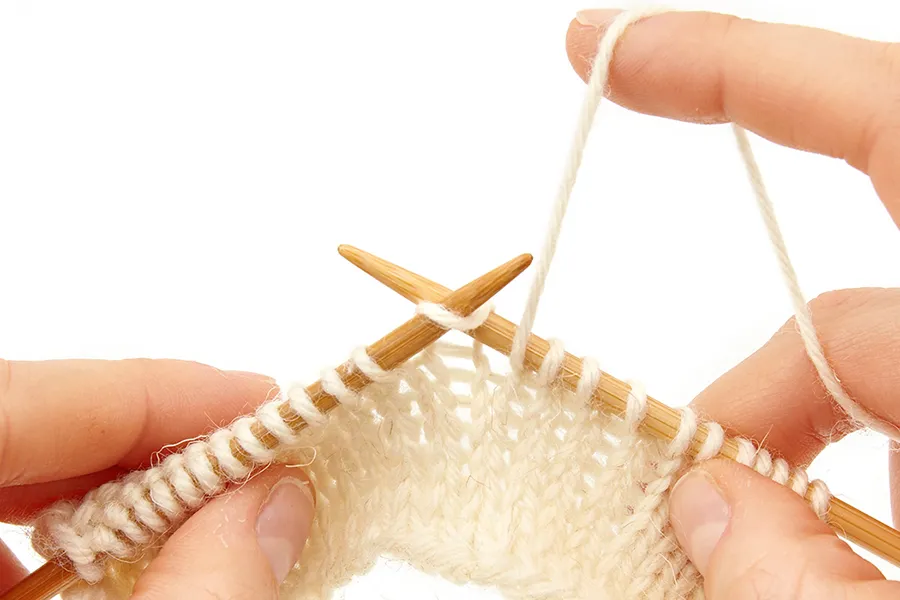
What feature really defines lace knitting? The holes, of course! Lace knitting’s beauty is in how these delicate holes are placed deliberately, and the easiest way to create these is with a yarn over.
This stitch creates an extra loop of yarn around your needle, which you work into on the next round as if it were just another stitch. It’s an increase, because you’re making a new stitch that wasn’t there before, and adds one to your stitch count. Since it’s a new stitch and there was no pre-existing stitch under it, a ‘yo’ also creates a hole in your fabric.
You’ll find a number of different terms used for yarn overs, such as ‘yarn forward’ (yf) or ‘yarn round needle’ (yrn). These generally mean the same thing, though they can also be used to describe the different ways of creating a yarn over if you’re working between two purl stitches, or a knit and a purl.
Between two purl stitches, wrap the yarn around the right-hand needle front to back to front so it ends up in purl position again. It’s well worth practising both yarn over variations.
- To learn the yo knitting stitch, see our guide on how to increase a stitch in knitting.
K2tog yo: how to knit 2 together yarn over
The ‘k2tog, yo’ (also seen as 'yo k2tog') is a classic pairing in lace knitting – the knit two together is a simple knitting decrease positioned next to a yarn over. The stitch count will remain constant, so you won’t get any shaping in your knitting just using this combination – this is perfect for a straight piece of fabric such as a scarf.
Although this stitch often forms part of a larger lace pattern, used on its own it’s also a great way to create simple eyelets in a piece of stocking stitch fabric. In this case, the k2tog decrease will appear almost invisible next to the hole created by the yarn over, so all you’ll see is a small, stable hole in the knitting.
This combination is a basic component of lace knitting, so it’s a good idea to practise it and get used to making yarn overs without even thinking about it.
Cast on for a small square of stocking stitch fabric. Then, every six rows or so, work the k2tog, yo, across the row, about ten stitches apart. You’ll see a pretty eyelet effect which you can work into any knitting pattern you choose. It can also be used to make buttonholes.
Step 1

Insert the right-hand needle into the next two stitches on the left-hand needle, from left to right. Wrap the yarn around the right needle and pull through the stitches.
Step 2

Bring the yarn to the front of your knitting, between the points of your needles.
Step 3

Purl back across the row you’ve just worked, and you’ll see a neat eyelet created in your knitting.
Lace knitting needles: 3 to buy
When first learning how to knit lace, you might want to choose a more ‘grippy’ bamboo needle, such as Clover Takumi (buy them from Amazon), which will help stop your stitches slipping off the end.
Circular needles with long cables are popular for lace knitting because they can hold lots of stitches with plenty of space leftover, meaning you can spread your knitting out to see the pattern more easily and check for mistakes. A pointy needle tip, rather than a blunt tip, will also help with stitches such as k3tog, where you have to push your needle through several stitches.
Many knitters swear by slick, sharp needles created specifically for knitting lace, and as you increase in confidence (and speed) it’s definitely worth giving them a go. We’ve chosen three of our favourites below.
1. Addi Lace circular needles

Addi Lace needles have been designed with lace knitting in mind. Their super-sharp ‘Turbo’ tips make it easy to work even the tiniest stitches, and a smooth join between tip and cable means your stitches glide effortlessly across the needle. It’s the perfect combination to allow for fast knitting, however complex your pattern.
The needles come in sizes 1.5mm to 8mm and lengths from 40cm to 150cm, with a choice of Polished White Bronze or slightly more resistant Brass tips.
2. ChiaoGoo Red Lace

Red Lace are ChaioGoo’s most popular needles, and it’s easy to see why. The stylish stainless steel tips are joined by a memory-free cable that promises not to coil and kink as you knit, while the smooth finish ensures slick, fast stitch movement.
Unlike many other needles, they also have the size laser-imprinted on the tips so it won’t wear off. ChiaoGoo Red Lace are available in 21 sizes and 8 lengths, so there’s a needle to match every project.
3. HiyaHiya Sharp interchangeable needles

If you’ll be knitting a lot of lace it’s well worth investing in a collection of interchangeable needles, and you can’t go wrong with this HiyaHiya Sharp set.
Made from sleek stainless steel with, as the name suggests, fantastically sharp tips, these needles are deservedly well-regarded amongst lace knitters. Tapered tips and snag-free joins make them great for knitting intricate stitches in the lightest of yarns. Plus it comes with lots of handy accessories!
Lace knitting yarns: 3 to buy
To make stunning, gossamer-thin lace shawls, you need lace weight yarn. This is generally the thinnest yarn weight used by knitters (see our yarn weight conversion chart) and, as its name suggests, it’s perfect for light and airy lace. We recommend three lace knitting yarns to try below.
Remember, though, that lace knitting doesn’t have to mean lace weight yarn. While many lace patterns are worked in super-fine yarn, lace can be knitted in any weight. If you’re a beginner you might find it easier to use 4ply or DK weight yarn for your first lace knitting project.
1. Debbie Bliss Rialto Lace yarn

Available in 20 solid shades, this 100% merino wool yarn is a popular choice for shawls and more. Its smooth handle and great stitch definition show off all those delicate lace stitches to perfection.
2. Rowan Fine Lace yarn

A luxurious blend of baby Suri alpaca and merino wool, Rowan Fine Lace is a delight to knit with and gorgeously soft to wear. With its chalky neutral tones and bold brights, the shade range has something for everyone.
- Buy Rowan Fine Lace from Etsy
3. Malabrigo Lace yarn

Famous for its stunning, hand-dyed colourways (there are 78 to choose from!), Malabrigo Lace is a super-soft 100% merino yarn that’s perfect for creating cosy cover-ups and timeless heirloom shawls.
Easy lace knitting patterns: 3 to try
1. Lace baby mittens

Welcome a little one into the world with these sweet heart mittens. They’re quick to work up in DK-weight yarn (which also makes it easy to see and keep track of your stitches), and a fun introduction to knitting from lace charts too.
- Cast on the baby mittens knitting pattern.
2. Lace wedding gift

Use this dainty lace pillow as a ring cushion, or fill it with sweet-smelling lavender and use it to keep your yarn stash moth-free! The lace edging is worked over just a handful of stitches – perfect for dipping a toe into the world of lace.
- Try our ring bearer pillow knitting pattern.
3. Lace wall hanging

Want to try a few different lace knitting stitches while making an on-trend decoration for your home at the same time? This sampler-style wall hanging includes five beginner-friendly stitch patterns for you to master.
- Get the free knitted wall hanging pattern.
Everybody loves a bit of lace
Now that you’ve learnt everything there is to know about lace, it’s time to put that knowledge into practice! The great thing about lace knitting is that there is a huge range of fine yarns available, and an even wider range of patterns for your new skills. Give some of our stitches a try to boost your skills.
Create clever cables
If you can manage lace knitting, then we think it’s time for your next knitting challenge – Learn how to cable knit.


